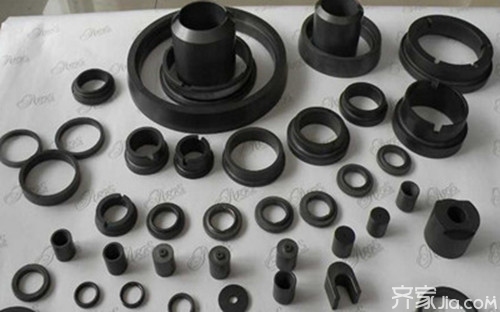Silicon Carbide Ceramics is a high-quality ceramic material with high strength, high thermal conductivity, good shock resistance, oxidation resistance, wear resistance, corrosion resistance, and other high-temperature properties. It is widely used in metallurgy, energy, and chemical industries. The following small series introduces the use of silicon carbide ceramics.

The use of silicon carbide ceramics
1, chemical, metallurgy
Silicon carbide has high resistance to hot metal, slag, and alkali metal erosion, as well as high thermal and wear resistance, from the 1970s to the early 1990s. Over 65% of the world's large-scale blast furnaces have used silicon carbide nitride silicon carbide as the furnace material, which has increased the service life of the blast furnace by 2096-40 percent. In the smelting of metal aluminum, copper and zinc, a large variety of silicon carbide materials have also been used as furnace linings or crucibles. In the chemical and metallurgical industries, ceramic heat exchangers are often used to preheat various gases or liquids in order to make full use of heat in exhaust gases of various kinds of furnaces.
2, energy and environmental protection
The direct purification of the gas at high temperatures can fully benefit the sensible heat of the gas used in the Hexolov heat exchanger. Compared with the normal temperature purification, it can greatly increase the thermal efficiency. The purified gas can be directly used for gas turbine power generation, which can greatly improve the power supply efficiency and reduce harmful substances. The displacement, save water. The use of gas turbine equipment and the standards for environmental protection in modern coal-fired power generation systems require the direct removal of high-temperature gas.
3, industrial furnace
Light industry, building materials, electronics and other industries use a large number of industrial furnaces, using a combination of different materials silicon carbide kiln furniture, can greatly reduce the weight of kiln furniture and the space it occupies, improve energy efficiency, reduce labor intensity. At the same time, due to the excellent anti-cooking impact properties of 48 SiC parts, the heating rate of firing can be accelerated.
4, a variety of additional devices
In materials sintering, melting, heat treatment, and the glass industry, indirect heating of gas is an important way. Compared with direct combustion heating, gas indirect heating can greatly increase thermal efficiency and reduce NO. Excluding harmful gases. At the same time, the stability of the temperature is increased and the control of the atmosphere in the furnace is ensured: simultaneously in many industrial heating processes, the workpiece is required to be isolated from the combustion environment.
5, heating elements
The important conductive property of silicon carbide is that it is made of 1000. C. The most important material of the heating element of the heating furnace, silicon carbide heating element is the most important product of silicon carbide material, with a great market.
The use temperature of related products in China has stayed below 1400°C for a long time. Since the 1990s, the use temperature of silicon carbide heating elements has generally been increased to 1,600" (2, for example, Cesi-wid, Germany, Japan Tokai High-heat Co., Ltd., compared with foreign products, China's product cold end / hot zone resistance ratio is generally only 1:10, lower than the foreign level (1:15), resulting in a waste of power resources.
6, mechanical seal
In order to improve performance, save fuel, and extend the warranty period, the automotive industry places higher demands on the cooling system. Due to the increase in the temperature and pressure of the automotive cooling system, the pump is required to have a higher speed and bear a higher load. One of the important factors in improving the service life of a pump is the problem of mechanical seals.
7. Silicon carbide composites for atomic energy industry
Silicon carbide materials have low neutron activation behavior (radioactivity under neutron action), low shutdown heat, low gas (especially nitrogen) permeability, and excellent high temperature mechanical properties, making it useful for nuclear power plant structures material. For example, the United States ARIFS nuclear power plant selects SiC fiber reinforced SiC as a nesting cladding material. With the development of nuclear power, the demand for high-performance silicon carbide materials will surely increase. 5l4 Conclusion Through the above summary of the preparation of silicon carbide materials and their engineering applications, it can be seen that silicon carbide is the most advanced engineering ceramic with the prospect of industrialization. It not only includes high-performance fine ceramics, but also covers from low to high. High-grade silicon carbide products with different performance levels.
The nature of silicon carbide
The molecular formula is SiC, its hardness is between corundum and diamond, its mechanical strength is higher than that of corundum, and it can be used as abrasive and some other industrial materials. Industrial silicon carbide was successfully developed in 1891 and was the earliest artificial abrasive. Although there is a small amount of silicon carbide in the meteorite and in the earth's crust, no sources have been found so far.
Pure silicon carbide is a colorless, transparent crystal. Industrial silicon carbide is light yellow, green, blue, or even black due to the different types and contents of impurities, and the transparency varies with its purity. The silicon carbide crystal structure is divided into hexagonal or rhombohedral α-SiC and cubic β-SiC (cubic silicon carbide). Alpha-SiC has formed many different variants due to its different stacking sequence of carbon and silicon atoms in the crystal structure, and more than 70 species have been discovered. β-SiC is transformed into α-SiC when it is above 2100°C.
The industrial production method of silicon carbide is made of high quality quartz sand and petroleum coke in an electric resistance furnace. The silicon carbide blocks obtained are obtained by crushing, acid-alkali washing, magnetic separation, and sieving or water selection to produce various particle size products.

Silicon Carbide Ceramic sintering method
1. Hot-pressing sintering: Only silicon carbide parts with a simple shape can be produced, which has low production efficiency and is not conducive to large-scale commercial production.
2. Pressureless sintering (normal pressure sintering): The ability to produce complex shapes and large-size silicon carbide parts is the most prevalent sintering method currently recognized.
3, reaction sintering: can produce complex shapes of silicon carbide parts, low sintering temperature, but the product high temperature performance is not good.
Editor's summary: The use of silicon carbide ceramics is introduced here, and it is hoped to help everyone. If you want to know more related information, you can pay attention to this website information.
Ceramic Bathroom Cabinets Europe and the United States Ceramic Ceramics Electric Cooker Ceramic Variety Ceramic Mop Pool
